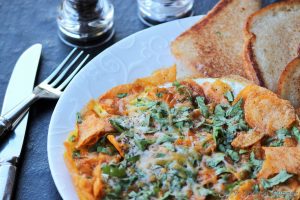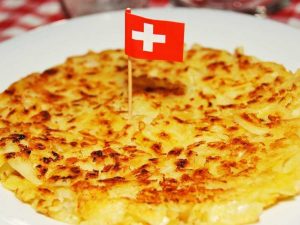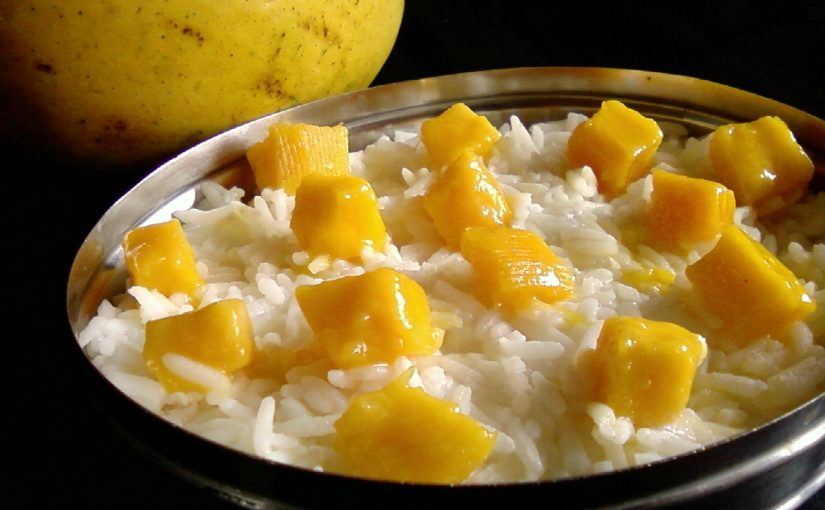COOL DOWN: With dahi-bhat/curd-rice which is a household classic down south India but summer time one may jazz it up with mango ripe (or any other fruit/veggie of choice); then `wafer par eeda’ (a Parsi breakfast dish); potato rosti (of Swiss origin)
Eating is Fun / Eating is Yuck! – A variety food column
By Tara Narayan
COME the sweaty month of May and the only charms are scarlet, red, peachy gulmohur blooms filling up my eyes (I always say these are the bridal trees of summer time) and then mangoes, of course. I don’t know why an Indian fruit like mangoes should come at such premium prices but you may answer that yourself. In any case I don’t know why restaurants in town don’t offer simple mango offerings like a bowl of cut mango or fresh mango puree (aam raas) on their menu. They offer all kinds of other mango concoctions with very little mango enshrined in them, but no pure mango puree served desi-style (Gujju-style is a pinch of ginger powder, salt and a teaspoon of desi ghee mixed in) or phoren-style (with fresh milk cream topping it/not synthetic cream), a pity.
I refuse to eat itsy bitsy confectionary pretending to be mango this or that, though I must confess once upon a time I relished the most scrumptious miniature mango curd tarts out at La Paz in Vasco da Gama (courtesy Chef Peter), these are divinely unforgettable and have stayed in my memory. I’m also looking for a good mango cake, mango cheese cake, mango panna cotta these days. Some places are serving the traditional summer favorite aam ka panna but aam ka panna is not a thick sweet sherbet! It’s a delicately roasted/baked/steam-cooked raw mango thirst-quencher sweetened just so with jaggery (not sugar, which only increases thirst if you’ve noticed). Can’t find honest aam ka panna tangy and redolent of freshly roasted jeera anywhere either!
It’s also hard to find honest mangoes. Last week I ended up buying half-a-dozen alphonso which looked so good from the outside – but at home when I cut them up they were sour in patches and with some black sponge disease eating into them. They were obviously superficially or chemically ripened. I chucked them all and to think I paid `40 per afoos! This is to say even when it comes to fruit life is so deceptive in our times.
There are other mangoes in the market of course, the totapuris, kesaris, malgese, the little ghotas which are useful for making Goan ambache sasav or mango curry (ghota mangoes one may find for `60-`100 per kg in the Panjim market). These hot summer days I keep making dahi–bhat (or curd-rice) for a light lunch – one day carrot dahi-bhat, another day cucumber dahi-bhat, and some days a pineapple dahi-bhat which is also very delicious. Once I tried out broccoli dahi-bhat but the hubby rejected it. He said make mango dahi-bhat and since then it’s been mango dahi-bhat lunch after lunch. Chilled mango dahi-bhat is delicious to eat.
My friend Elizabeth asked me how I make mango dahi-bhat, here is the basic recipe which can be innovated on with one’s own imagination though there’s virtue in keeping it simple too! Okay, mango dahi-bhat coming up.
TAKE two firm ripe mangoes of your choice (but they must be table mangoes like honest afoos or kesari which are the best because they are not so fibrous). Wash, skin and cut the mangoes into chunks/dice and keep aside. Cook a katori of basmati/ambemor rice or any rice you fancy, and keep aside. Make half-a-litre fresh curd and keep aside.
NOW do the phodni or tempering: Heat a tablespoon of olive oil/desi ghee. When hot enough put off the fire and quickly add in half tsp mustard (fenugreek) seeds, a pinch of hing (asafetida), a few sprigs of tender curry leaves, and a handful of caju if you like. Add rock salt to taste, stir. Add in the chopped mango pieces, stir gently. Add in the rice, stir gently. Top it all with generous dollops of fresh curd or dahi and stir gently. Serve with a garnishing of green coriander leaves if you wish. Stir gently and serve. Enjoy your mango dahi-bhat.
Some folk like to stir in mango puree but I prefer mango chunks. I’m talking of just-ripe but not over-ripe mango chunks. Raw mango bhat is another recipe but without the curd. Natural home-made curd, you must know is one of life’s probiotics and keeps one’s microbiome or population of gut bacteria happy! Ripe mango dahi-bhat is deliciously sweet, sour and a light, cooling lunch. My Tam Brahm eccentrically vegetarian hubby makes a meal of it with papad/potato chips/gram flour boondi as garnish.
WHICH reminds me I’ve lately discovered Mongini’s pack of potato wafers, they’re very good indeed, thinly crunchy, flavourful and only a wee bit salted. One gets the flavour of potatoes in these wafers or chips if that’s what you want to call them. Perhaps Monginis’ boss could consider marketing the wafers in salted/lightly salted versions, that would be a real boon for potato wafer lovers who’ve been told to lay off salt if they don’t want to pickle their arteries further! Wafers are also fryums of course, so I try to resist them but they’re irresistible, and potato wafers this good tempt me to make an old favorite which is a Parsi-styled potato wafer omlette. “Wafer par eeda,” the Parsis call it–this is one community which has made an art out of serving up eggs in various simple and exotic ways.

 Nothing to making wafer par eeda: A Parsi friend of mine in Mumbai would put a little water in a pan, drop in a handful of potato wafers and then atop it pour beaten egg mixture with chopped onion, tomato, green chili, green coriander in it. Cover and let cook. When set, remove and enjoy. The wafers retain their crispiness with a chewy texture here and there which is not disagreeable. I’ve quite forgotten how precisely my friend used to make it and just remember the flavour of her wafer par eeda…it was something scrumptious and a ‘comfort breakfast’ as she called it.
Nothing to making wafer par eeda: A Parsi friend of mine in Mumbai would put a little water in a pan, drop in a handful of potato wafers and then atop it pour beaten egg mixture with chopped onion, tomato, green chili, green coriander in it. Cover and let cook. When set, remove and enjoy. The wafers retain their crispiness with a chewy texture here and there which is not disagreeable. I’ve quite forgotten how precisely my friend used to make it and just remember the flavour of her wafer par eeda…it was something scrumptious and a ‘comfort breakfast’ as she called it.
Anything with potatoes in it has to be comfort food, right? But apart from wafer par eeda one of these days try making the Swiss potato omelette called rosti, it’s a little tricky to make and you may want to try out the two versions – using grated raw potato or par-boiled potato cooled in the fridge and grated at time of cooking. Making a light-hearted buttery rosti is really an art and only Elizabeth at Lila Café out in Arpora has the magical touch. A rosti has to be lightly golden brown outside, buttery soft inside. Eat as is or in combo with croissants with lashings of butter and orange/lemon/grapefruit marmalade alongside and natural cheddar alongside. Pretend you’ve just tramped up hill and down dale in Alpine country and deserve all the calories of a buttery rosti!
If you’re asking me, potatoes are the one veggie which has inspired scores of only potatoes cookbooks. I have some of them but just can’t find them when I need them. There are potatoes and potatoes and all kinds of potato talk. It’s not only Europeans or the Irish or the Germans who have a reputation for eating potatoes morning, noon and night. We Indians too may eat them round the clock. Although potatoes are not at all native to India and come to us courtesy Portuguese colonialism (along with tomatoes, brinjals, cashewnuts, pineapples, avacadoes…and how can I forget chilies, none of them are Bharatdesh natives, okay).
Potatoes were first cultivated from the wild in South America some 8000-5000 years BC and were the staple crop of Andean/Peruvian/north-west Bolivian people. European colonists took them to Europe, India and south-east Asia and since then potatoes (Solanum tuberosum) have become so adored that most of us recognise them and are perennially hung up on them.
I mean can you think of a meal menu which will not feature at least one potato dish? Sukha aloo bhaji is always there in any thali meal. The one at Bhojan at Hotel Fidalgo in Panjim has a very decent sukha aloo bhaji and I always want to buy some but they won’t let me buy it piecemeal (it’s either the whole thali or nothing doing.) The Bhojan vegetarian thali does feature aam raas these days but check before you go. If I make the sukha aloo bhaji at home I welcome leftovers to turn into aloo paratha in the evening (mash the bhaji and add chopped green coriander for a fresh touch)! Mashed sukha aloo bhaji may also be stuffed in toast (serve it with Maggi Tomato Chili Sauce).
Hey, don’t knock potatoes. They’re actually super good food boiled, baked, roasted, mashed—until we turn them into fat-laden affairs with ghee, butter, cheese, cream, olive oil, etc. Potatoes are said to be rich in vitamin B and yes, vitamin C, manganese, phosphorus, other mineral values, pantothenic acid (vitamin B5), etc. In Naturopathy raw potato juice is prescribed for those who suffer from gout/joint pains.
All raw veggie juices have an alkaline influence on our body chemistry but then the hunt is for organically cultivated potatoes. Hard to find in our manipulative, money-driven times. Of course one may include raw potato juice in a cocktail in combo with tomato, lemon, coconut water, etc. These days in the health-conscious circuit, veggie/fruit cocktails are all the rage with the students community. It is thumbs down to bottled aerated drinks which I think should be banned anyway (they are that deadly)!
Do you know potatoes are the fourth largest cultivated crop after rice, wheat and maize? We in Goa are also lucky to have sweet potatoes. Magenta and white in color, the knobbly fist-sized ones are delicious just plain steam cooked. They are also delicious tossed in a bit of mint chaat masala or turned into mashed sweet potato spread atop a toast. Check it out. Try turning them into baked wafers a la the Terra purple wafers which some five-stars have taken to serving along with their cocktails and appetizers.
The Terra Blues/Terra Sweet Medley wafers (which are non-GMO and baked) are imported from USA by the Tree of Life people and priced `400 or so per scanty pack. Can’t even think of buying these imported wafers of “taro, sweet potato, batata, parsnip, yucca….kissed with beet juice!” Terra wafers have been around for 20 years in the USA but recently arrived in our urban markets, and already there’re a lot of Indian copycat wafers, we Indians are great copycats!
While doing some homework I discovered a Control Alt company from Mumbai doing wafers of kale (`200 per packet). This niche segment offers more quality-conscious wafers but one never knows until one eats them, and after reading the fine print on the labelling which may not even be there on Indian copycat phoren-styled products!
